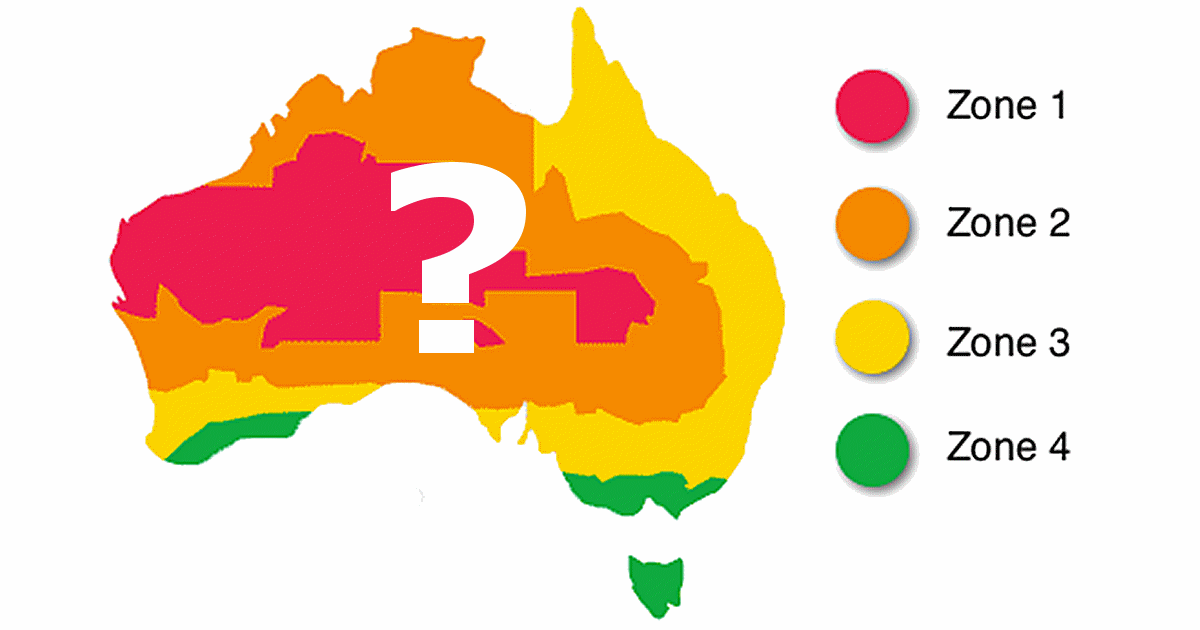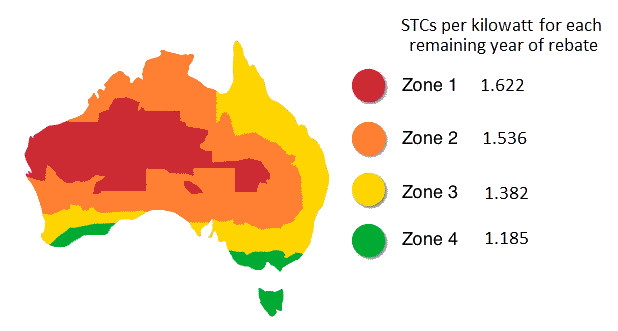
Australia’s Clean Energy Regulator has announced changes to postcode zones for solar power system installations will kick in from the beginning of next year; impacting on the amount of subsidy available in some areas.
Australia’s major PV subsidy, aka the solar rebate, is based on Small-scale Technology Certificates (STCs). The number of certificates a system is eligible for depends on:
- The system size (solar panel capacity).
- The installation date (how many years before the scheme finishes, which is at the end of 2030).
- Where it is installed – i.e. the postcode.
Postcodes are allocated a zone (1-4) based on what has been determined as their solar radiation levels. Each zone level is accompanied by a different multiplier on which the calculation for the number of STCs is based. The lower the zone number, the more STCs a system is eligible for.
Here’s the multiplier used:
The formula for calculating STCs is:
multiplier x panel capacity (kW) x years left in scheme
Assigning zones to postcodes isn’t an exact science – for example, a house on the edge of one postcode may be eligible for more STCs than one just across the road in another postcode where the solar radiation levels would be exactly the same.
Back in June, we reported the Clean Energy Regulator was wanting feedback on proposed changes to solar postcode zones – and the entire process is now done and dusted. The changes were to have been implemented in October this year, but will now take effect from January 1, 2020.
Regulator Says More Winners Than Losers
The Regulator has again stated:
“The majority of postcodes will not be affected. Most postcodes with changes will be eligible for more STCs and a few postcodes will receive fewer STCs.”
When the proposed changes were published, I noted one example after a quick search where a location would receive fewer STCs – postcode 5654 in South Australia. In that instance and had the changes taken effect this year, the difference would have been 12 fewer STCs on a 6.6kW system – which worked out to roughly $440 less subsidy based on an STC value of $37.
The change for that postcode remains in the final decision – it was previously Zone 2 (1.536 multiplier) and will be considered Zone 3 (1.382 multiplier) from January 1, 2020. It’s not clear how many postcodes are impacted one way the other as the Regulator didn’t mention any numbers.
Added to this change is a reduction in the subsidy nationwide from January 1 as part of the “rebate” phaseout that might also add to the cost of a system – but some/all of this aspect might be absorbed by other factors.
If you’re scheduled to have a system installed soon, you might want to check out the old (current) vs new postcode zones to see if you should perhaps hold off or try to accelerate installation; but good luck on the latter given the time of the year.
It’s possible some solar companies won’t be aware of these changes, which could create interesting situations with quotes and contracts where systems are intended to be installed in affected postcodes early in the new year.
Some may have wording in documentation in relation to STC value (which can vary with market conditions), and all installers would be aware of the reduction in STCs on January 1 in relation to the scheduled winding down of the rebate – but perhaps not this situation.


 RSS - Posts
RSS - Posts



Clear as mud!
Is it possible to get a calculator to work out savings / cost on a 4.2 system.
My postcode has changed from Zone 4 to 3
Just as an aside, my system was due to be installed on December 9th but now not til end of January as they say they cant get Inverters (Fronius)
It’s a big company with many good reviews but I feel very frustrated by the whole deal.
A very unsatisfactory process as everything booked in and done and then advised the Friday before install can’t do.
They Also offered to refund my deposit but it means going thru the whole process again…which I don’t want to do
Jo – do you want to know the value of the STCs or the financial savings of the system?
I would like to know if I should be financially better off with the new postcode. My install was Dec 9 now been put forward to end Jan. After some discussion they agreed to lock in Dec price…which is only fair as they delayed the install.
“After some discussion they agreed to lock in Dec price…which is only fair as they delayed the install”
I ask you how you go about buying something that is simply not available and how you’d take to suffering a penalty (over and above that of not having it) for not being able to get your hands on that something? It’s out of your installer’s and every other installer of premium products hands as these inverters are simply not available and from what I’ve read even the expected delivery dates to the wholesalers are not reliable.
If you did not want to go with another inverter and wanted to wait for Fronius, then surely it is your cost and not the installers’. If your installer is prepared to wear that cost then surely you should be singing their praises; not unappreciatively blaming them for something they have no control over. Your installer is too nice.